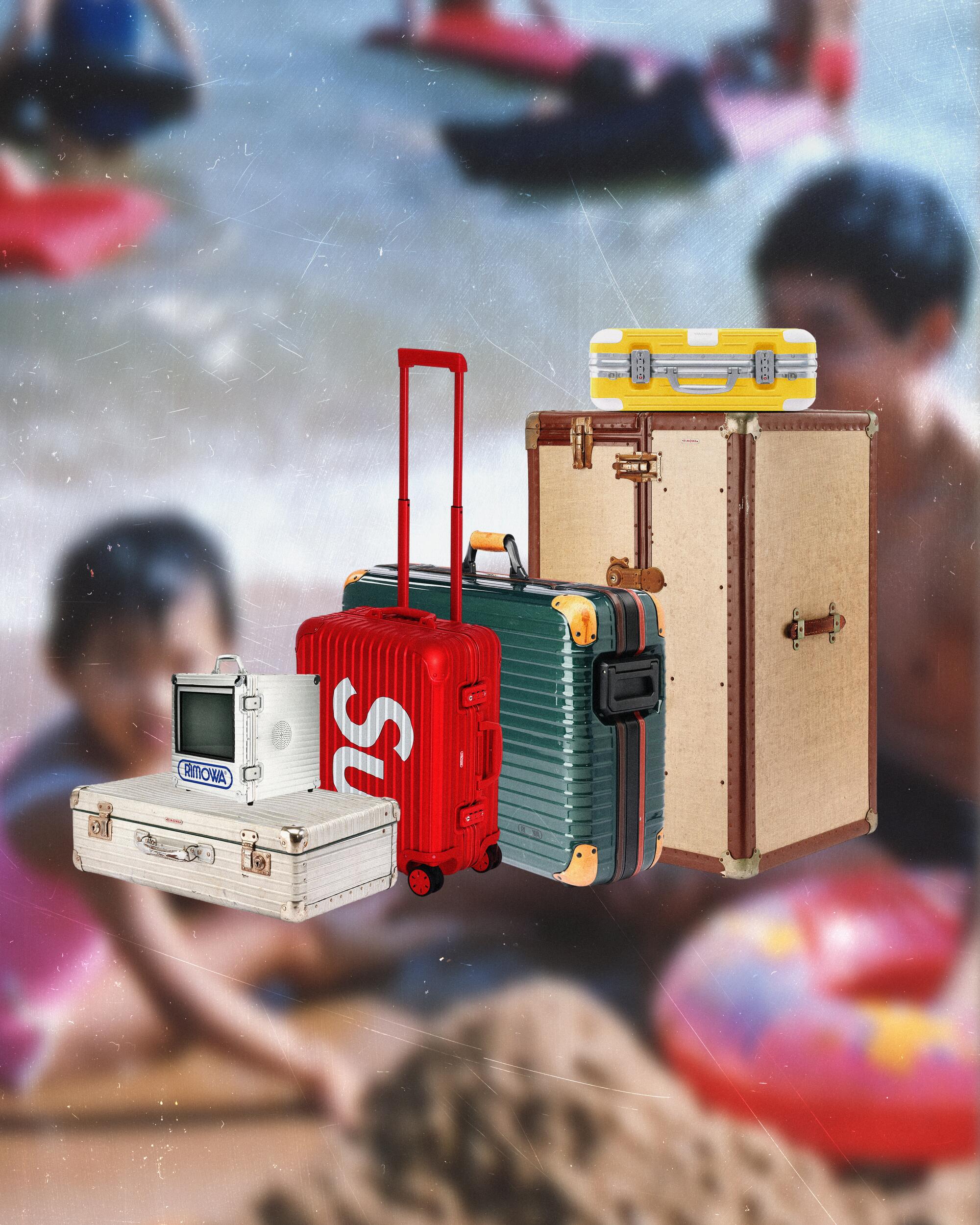Listen. That’s the low hum of the highway you hear behind me, offset by the rumble of the ice machine down the breezeway. We gather today to celebrate the motel, a uniquely American creature, conceived in California through the unholy embrace of the automobile and the hotel.
Since that beginning in 1925, motels have multiplied like bunnies. They have been implicated in countless crimes and liaisons. They have been elevated by some savvy architects, undercut by assorted chain operations and frequently left for dead by the side of the road.
The motel turns 100. Explore the state’s best roadside havens — and the coolest stops along the way.
Yet certain survivors have done some dramatic social climbing, especially lately. Plenty of motels have moved from budget to boutique, often renaming themselves as inns, lodges or hotels and capitalizing on their vintage looks. Like turntables, typewriters, tiki bars and film cameras, these midcentury motels are back, seducing millennials, Gen Z and baby boomers like the character Johnny Rose on the beloved TV series “Schitt’s Creek.”
“I always saw motels as a last resort, a dreaded pit stop,” said Rose, played by Eugene Levy, pitching Wall Street investors. “But I was wrong. Motels have the potential of offering a window into the unique charm of small-town life.”
He vows “to revitalize the classic roadside motel for a new generation.”
Out here in the real world, it’s happening.
Nowadays you can spend $1,000 a night in a born-again California motel. You can order “eight-minute eggs” with your Champagne brunch (Le Petit Pali, Carmel), browse in a curated bodega (Hotel Wren, Twentynine Palms), nosh on caviar (Skyview Los Alamos), borrow a small car (Surfrider Hotel, Malibu), or ease the planet’s miseries by reaching for tree-free toilet paper (Pearl Hotel, San Diego).
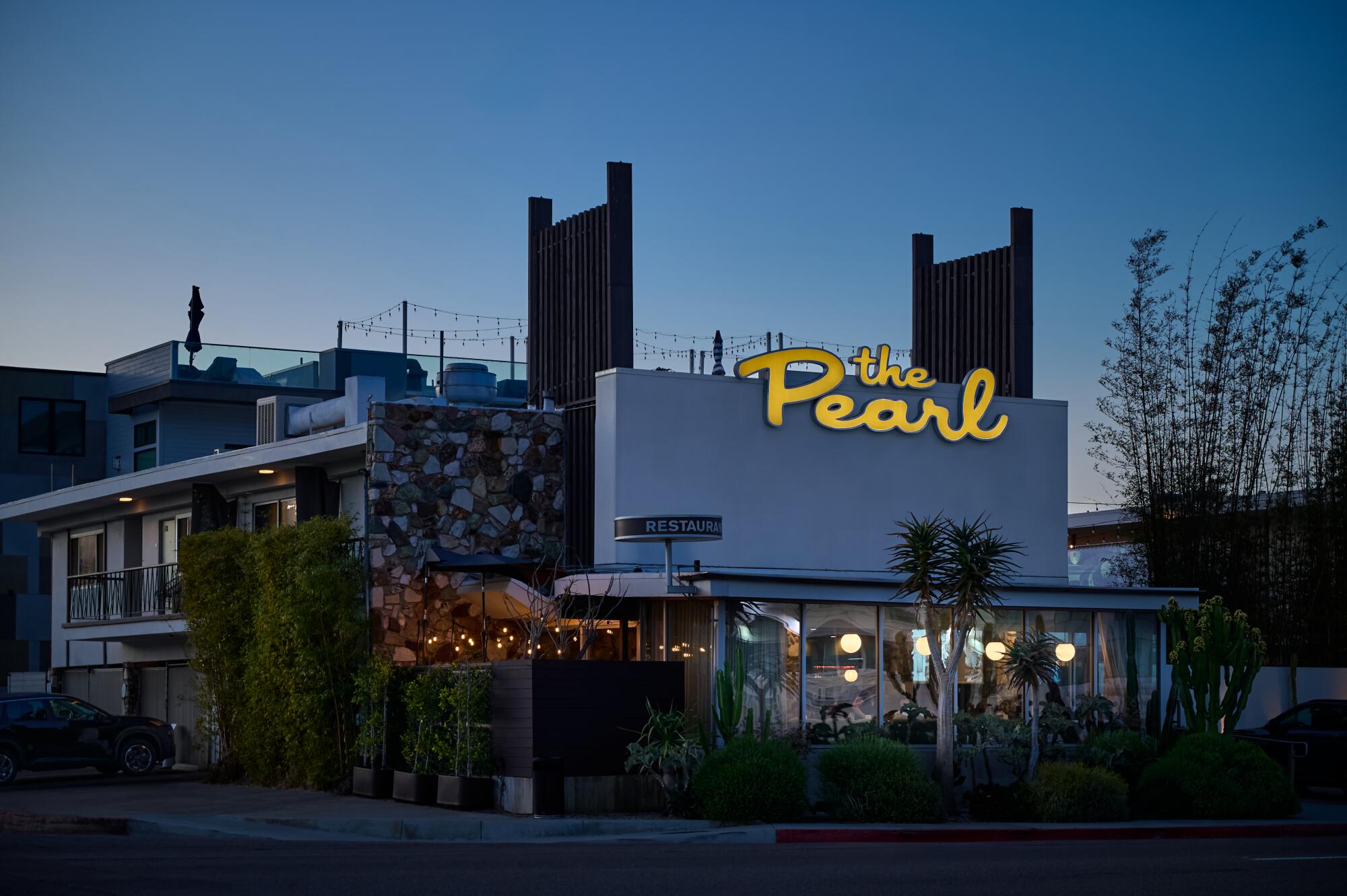
The cursive yellow sign at the Pearl reverberates with ’50s vibes.
(Megan Morello / For The Times)
Yet if you’re nervous about money in these nerve-racking times, you can still find a mom-and-pop operation with high standards, a long family history and — sometimes — rates that dip under $100. You can even find one of those that features concrete teepees (San Bernardino’s Wigwam Motel, run by a family with roots in India).
In other words, it’s a wide, wide motel world out there, too broad to fit into one road trip. And so, in honor of the motel centennial, I took a road trip. Well, a few road trips.
All told, I covered about 2,500 miles, all within California, stalking properties born between 1925 and 1970, avoiding the big chains, sleeping in a new room every night. The way I defined a motel? If a lodging’s guest rooms open directly to the outdoors and there’s a parking lot handy, industry experts say, it probably was born as a motel or motor lodge. Especially if it’s a low-rise building with fewer than 60 rooms, brick walls and a VACANCY sign visible from the street. But owners can call their lodgings what they like — or turn them to other uses.
On the way, I found a few landmark motels that don’t take overnight guests at all. I also learned how the state’s Project Homekey — conceived to house people at risk of homelessness — bankrolled the purchase and conversion of more than 30 Southern California motels and hotels from 2020 to 2024, with mixed results.
Now, buckle up and let’s roll the montage of old postcards, weathered neon signs and swooping Googie rooflines, then zoom to the spot where motel history began.

The Mo-Tel is born
The first stop, I knew, needed to be a scruffy lot alongside U.S. 101 at the eastern edge of San Luis Obispo.
This is where a car-loving Pasadena architect named Arthur Heineman opened his first roadside lodging in December 1925, less than a year before Route 66 connected Chicago to Los Angeles. Having seen the first vacation camps and motor courts spring up across the country, Heineman hatched the idea of building one midway between Los Angeles and San Francisco.
After a few false starts, he called his place the Milestone Mo-Tel, combining motor and hotel. Later it became the Motel Inn. Heineman gave the buildings Mission Revival features and planned to build 18 statewide, his own mission system.
That never happened. But Heineman’s lodging endured for decades and the word motel caught on. As the automobile transformed American life and roadside commercial culture lit up like a new neon light, that word spread.
But we’re not lingering at the Motel Inn. It shut down in 1991 and much of the old complex has been leveled. Despite a proposal for a new hotel that got local planning commission approval in 2023, the site remained idle as of March 7. An uninspiring sign still stands, along with a Mission-style office building, bell tower and a single wall from the old restaurant. For someone who prizes roadside Americana, this is the visual version of the sad trombone sound.
Fortunately, the Madonna Inn — the visual version of an accordion orchestra — is just three miles away. Under a big pink sign.

When one California castle is not enough

At he Madonna Inn in San Luis Obispo, Alex Madonna drew on his Swiss background and gave the inn a mountain-chalet look.
(Christopher Reynolds / Los Angeles Times)
Nowadays the Madonna Inn is a vast enterprise with restaurants, bakery, bar, stables next door and 110 guest rooms — each different, each with its own postcard in the inn’s three gift shops. It’s so ornate, so frothy with kitsch, you have to smile. But when Alex and Phyllis Madonna opened in late 1958, the inn was a 12-room experiment.
The timing must have seemed right. Motels had been multiplying nationwide for more than 30 years, often adding swimming pools to lure more families or adopting elaborate themes to stand apart.
On Columbus Avenue in San Francisco, a circular Villa Roma motor hotel rose up (until it was leveled in the ’80s). Farther north in Crescent City, a man named Tom Wyllie built the 36-room Curly Redwood Lodge out of a single redwood tree in 1957. You can still sleep there, often for less than $80.
But here’s what gave the Madonnas a crucial boost on their motel in San Luis Obispo: Earlier that year, the state of California had opened the ornately furnished Hearst Castle in nearby San Simeon as a tourist attraction. Once the Madonna Inn opened that December, a traveler from L.A. could sleep at one lavishly decorated only-in-California castle on the way to another. Legions still do.

Scenes from the Madonna Inn. (Christopher Reynolds / Los Angeles Times)

(Nic Coury / For The Times)
“It is the grandest motel of them all,” roadside design expert John Margolies once wrote, “and it is the definitive expression of an individually owned and operated hostelry — light-years removed from the almost scientific sameness of the large franchised chains.”

Boom, bust and boom again in San Francisco
From San Luis Obispo I drove on to San Francisco, ignoring Union Square, North Beach and Fisherman’s Wharf, heading for the straight part of Lombard Street. That’s the part that carries U.S. 101 traffic through the Marina district on its way to the Golden Gate Bridge, and it’s full of old motels. In their vintage signs and often-weary façades, you can see proof of the industry’s boom and the decline that followed.
How ubiquitous did motels get? By 1964 there were 61,000 motels across the U.S. It’s hard to imagine there were ever so many, until you peek at @deadmotelsUSA or @merchmotel on Instagram or you’ve come across Heather M. David’s splendid 2017 coffee table book, “Motel California.”
Alas, by 1964, they were already beginning to get less interesting. Once the first generation of mom-and-pop motels prospered, the first chain operations arose and followed, targeting travelers who wanted no surprises. Two of the biggest chains, in fact, were born in Southern California — Motel 6 in Santa Barbara and Travelodge in San Diego.
As the national freeway system grew through the 1960s and ’70s, more chain operations positioned themselves to collect freeway drivers. Along the now-much-quieter highway, the old mom-and-pop operations died off or were gobbled up and “reflagged” by the chains.
By 1980, the freeway system and the chain hotels were thriving. Motels, not so much.
But in 1987 — in San Francisco’s Tenderloin, of all places — a 26-year-old Stanford MBA named Chip Conley tried something that changed the motel narrative. He bought a bedraggled old place called the Caravan Lodge and dubbed it the Phoenix, with Miss Pearl’s Jam House as its on-site restaurant and bar. Then he positioned the property as a hotelier’s version of Rolling Stone magazine, all wrapped around a playfully painted pool. And he offered free massages and bus parking to touring musicians’ road managers.
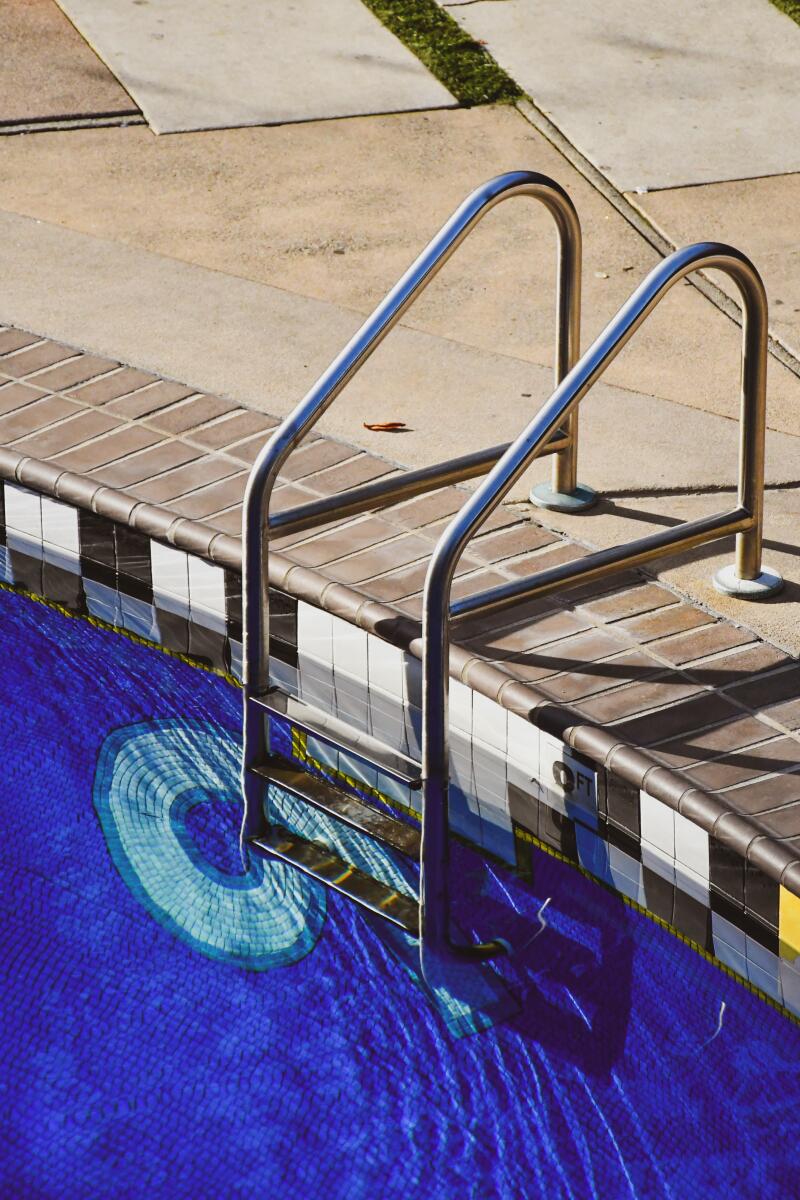
The Phoenix Hotel is part of the hipster-friendly Bunkhouse hotel group. (Christopher Reynolds / Los Angeles Times)

(Christopher Reynolds / Los Angeles Times)
And lo, the bands came, including the Red Hot Chili Peppers, Sinead O’Connor, M.C. Hammer, k.d. lang, Laurie Anderson, Etta James, David Bowie, Bo Diddley and Deborah Harry. As the Phoenix flourished, Conley revived dozens more motels and small hotels, conceived a brand called Joie de Vivre, then sold it to Marriott.
The Phoenix has less momentum now. Its restaurant opens only for special events and the Tenderloin’s crime and blight persist. If I were in the city with children, I’d sooner stay near Lombard Street at the Motel Capri or Hotel Del Sol (which charges a staggering $45 for parking but has a pool).
Then again, a new owner took over the Phoenix last August — Michel Suas, a celebrated Bay Area pastry chef. If any Phoenix can rise from the ashes twice, it’s this one.

Rethinking rooms for a new generation
Meanwhile, up and down California, there’s a new generation of motel entrepreneurs and designers following Conley’s lead, rethinking what it means to be a motel. Though the nationwide number of motels dwindled to an estimated 16,000 by 2012, reclamation projects have been multiplying.
Kenny Osehan’s Ojai-based Shelter Social Club manages six reclaimed California motels in Ojai, Santa Barbara, Los Alamos and Solvang.
The Beverly Hills-based Kirkwood Collection includes 11 redone California motels and hotels.
The Santa Barbara-based Casetta Group has opened four redone Southern California motels and hotels, with two more opening soon in Los Angeles and Taos, N.M.
The San Luis Obispo-based Nomada Hotel Group has relaunched five motels and hotels along the Central Coast.
None of those companies existed before 2012. All are still growing and trading on the idea that a lodging with 30 rooms feels friendlier than one with 300.
Drive south from San Francisco with a motel geek — which you’re now doing, by the way — and the born-again motel variations roll past like Kodachrome images in a slide show.
At the Glen Oaks Resort Adobe Motor Lodge in Big Sur, the rooms huddle at the edge of a thick forest. You turn an old-school metal key in your door and find a room full of stylishly recycled furnishings — woodsy but luxe, with yoga mats leaning in a corner.
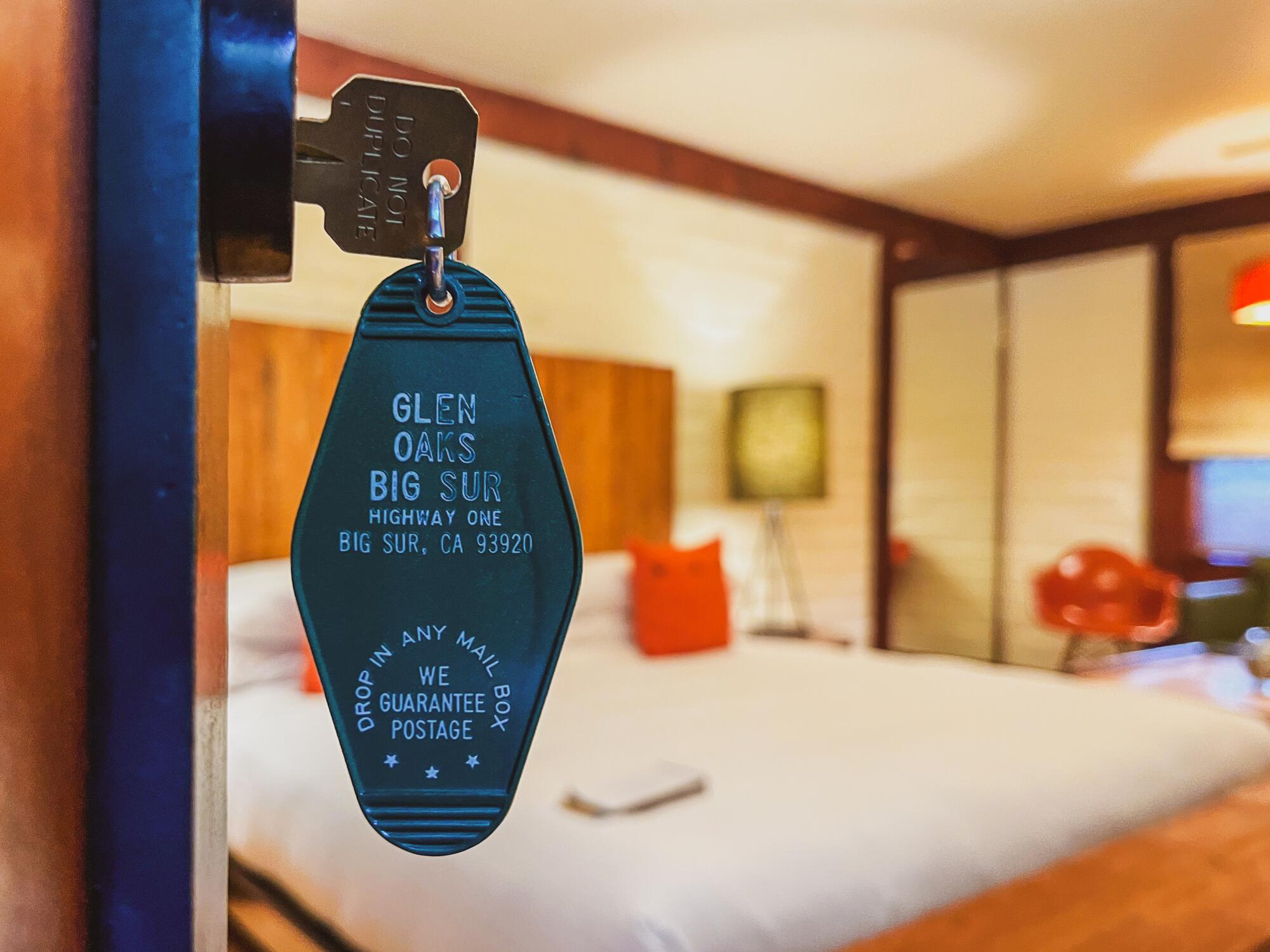
A vintage-style key at Glen Oaks Motor Lodge in Big Sur.
(Christopher Reynolds / Los Angeles Times)
At the Cambria Beach Lodge, where once you might have found a bedside Gideon Bible or a Magic Fingers vibrating mattress, now you borrow a bike to ride by Moonstone Beach or bathe with some of the motel’s goat’s milk soap.
Rolling through Paso Robles, you confront a generational motel choice. You can seek reassurance at the Melody Ranch Motel with its tidy, basic rooms, Gideon Bibles, second-generation family management and rates around $100 a night. Or you can head to Farmhouse Paso Robles or the River Lodge, both of which have been updated dramatically by the Nomada Group.
“It’s not that we set out to refurbish motels, necessarily,” Nomada partner and creative director Kimberly Walker told me. “One thing we are passionate about is giving old buildings a new chapter. We can’t ever see ourselves buying a piece of land and starting from scratch.”



Clockwise, from above: In April 2024, River Lodge reopened as a retro-chic boutique lodging. (Jacob Tovar / For The Times) Melody Ranch Motel has a prime spot on Spring Street, the main artery of Paso Robles. (Christopher Reynolds / Los Angeles Times) A cocktail at the River Lodge. (Jacob Tovar / For The Times)
With the best old motels, “There was just so much personality and thought put into what these buildings look like that they’re able to be reconceptualized again,” Walker said. “You can always find one thing to start your design journey with, and then build off of that.”
Two of the biggest challenges, Walker said, are parking and bathrooms. At the River Lodge, Skyview Los Alamos and Hotel Ynez in Solvang, Walker’s team moved the parking area farther from rooms, making more space for greenery and patios. In small bathrooms, the team has deployed fancy tiles, lots of light and glass partitions instead of shower curtains.
Especially at Skyview, the combination of Modernist and farmhouse design elements yields entertaining results. Agrigoogie, anyone?
And then there’s the question of those cool old signs that say motel.
“When we first bought Skyview, and I hate that I did this, but I was like, ‘Maybe we should change the sign from “motel” to “hotel,”‘” Walker confessed. “I’m so glad that I didn’t follow through with that, because the motel sign is the beacon. Guests love taking their pictures with the sign.”
In Cayucos, design veterans and hospitality newbies Ryan and Marisa Fortini faced a similar question when they bought and renovated an old motor inn on the main drag. They chose to lean even harder into the m-word and called their project the Pacific Motel. It opened in 2022.
And now the Fortinis are doing it again. In 2023 they bought the nearby Cayucos Motel. So far, that still-open property remains as beach-rustic-plain as the Pacific Motel is beach-rustic-chic. But more changes are coming and Ryan Fortini shared with me a new word that may help describe them.
“Motique,” he said. “A boutique motel.”

The Pacific Motel in Cayucos. (Jacob Tovar / For The Times)

(Jacob Tovar / For The Times)

Motel variations: Hot springs, beachfront perches and iconic signage
The farther south you go, whether on the coast or in the desert, the wider the variety seems to get.
At the Surfrider Malibu, guests ordinarily have exclusive access to a roof-deck restaurant, several loaner surfboards and a pair of Mini Coopers — but some amenities are on hold as the hotel accommodates many guests displaced by the Palisades fire in January.
In the boulder-strewn hills between San Diego and Calexico, the revivers of the once-moribund Jacumba Hot Springs Hotel have rebuilt that resort (which opened in 2023) with geothermally heated pools and a global desert theme.
On a pier in San Diego’s Pacific Beach, there’s been no dramatic rebirth — because none was necessary. The tidy cottages of the Crystal Pier Hotel, run by the same family since 1961, still look much as they did in the 1930s, tide lapping below, reservations required months ahead. (And you have to make them by phone or in person.)
“The motel thing is coming back,” said general manager Julie Neal, sounding surprised. “It’s actually kind of cool now.”
Out in the desert, where Midcentury Modern design has never gone out of style, there were revived motels left and right.
The most subdued of those was one of the most tempting: Hotel Wren in Twentynine Palms, which only opened in March, a 12-room, high-end retreat with muted colors, enormous rooms, custom furniture and poolside mountain views.
The least subdued? That would be the former Ruby Montana’s Coral Sands Inn, in Palm Springs.
My family and I booked most of the place with friends several years ago, and I was struck then by how entertaining it was to sleep, read and play in a seven-room motel that had been painted pink and filled with thrift-shop tchotchkes and vintage furnishings.
Well, Ruby’s gone now, and the Trixie Motel (its name since 2022) is proof that even if one hotelier goes wild, there’s still room for the next one to go wilder. Especially if that next owner is a drag queen.
The motel is still pink, but now staffers wear pink outfits, every room has its own custom thematic wallpaper (Atomic Bombshell, Pink Flamingo, Yeehaw Cowgirl). Barbie dolls cavort in the office and trendy persons fill the motel’s Barbara bar. Next to all this, the Madonna Inn looks like just another Ramada.
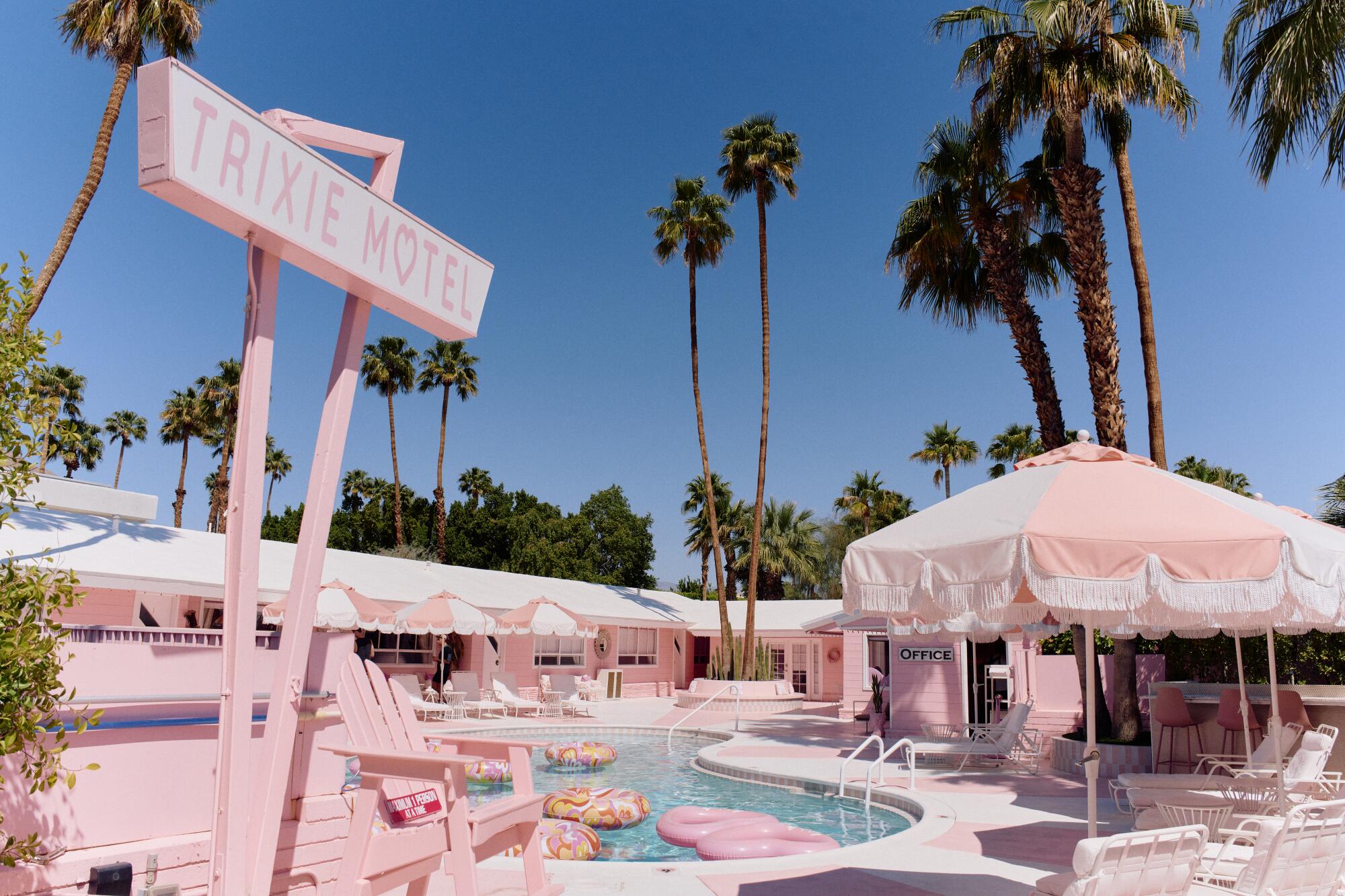
Drag queen Trixie Mattel, David Silver and Team Trixie (including interior designer Dani Dazey) bought the motel, renovated and reopened it in 2022. It’s now pinker than ever.
(David Fotus / For The Times)



(David Fotus / For The Times)

The road ahead runs through the middle of nowhere
Because the point of a motel is to help you toward someplace else, there’s no perfect way to end a motel journey. But Amboy works.
It’s a 20th century ghost town along Route 66, about 45 miles northeast of Twentynine Palms. Roy’s Motel & Cafe stands there like a forgotten stage set, topped by an iconic 1959 sign whose promises are all false.
Roy has been gone for decades. With potable water in short supply, neither the cafe nor the motel nor its six roadside cottages have been open since the 1980s. But Roy’s has gas, snacks and souvenirs, which is enough to attract film crews, selfie snappers and legions of drivers (especially desert-smitten Europeans) on their way between Las Vegas and Joshua Tree.
With Route 66 turning 100 in 2026, Roy’s owner Kyle Okura and manager Ken Large are doing their best to somehow get the six roadside cottages up and renting before that year is over. (Who can resist a centennial?)
It’s too soon to tell if that rebirth will happen. Still, the road warriors come, including off-duty trucker Chris Birdsall, 51, of Omaha, who turned up shortly before sunset one recent day.
“I want to see the sign lit up,” he said.
Soon after, Roy’s assistant manager Nicole Rachel called Birdsall into the old motel office, showed him the three switches that control the 50-foot sign and invited him to do the honors.
Birdsall did his bit, then grinned like a kid as the motel sign blinked to life in red, blue and yellow like a neon mirage or a road-tripper’s dream.
Rachel often invites visitors to throw the switches, she told me. But even if you don’t get that privilege, I can’t think of a better place to stand on the blacktop and imagine what might be down the road.
Christopher Reynolds / Los Angeles Times



